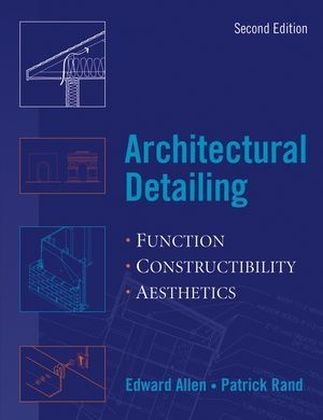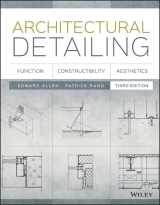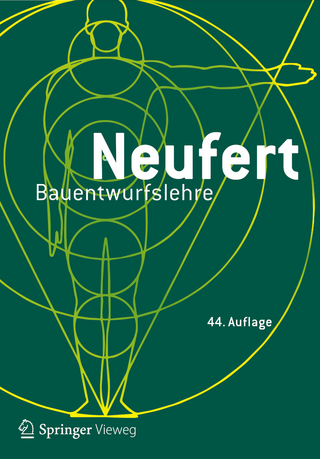
Architectural Detailing
John Wiley & Sons Inc (Verlag)
978-0-471-48817-0 (ISBN)
- Titel erscheint in neuer Auflage
- Artikel merken
This edition of the industry standard on architectural detailing includes new sections covering analysis and modification of existing details and design of new details, both basic and advanced. Revised to address sustainability and to reflect the International Building Code(r), Architectural Detailing continues to deliver reliable, insightful information on how to design details that will be water- and airtight, control the flows of heat and water vapor, adjust to all kinds of movement, age gracefully, be easy to construct, and still look good. Conveniently organized by the three major concerns of the detailer-function, constructibility, and aesthetics-this edition features: * Richly illustrated examples of detail design, case studies, and practical exercises.* New and revised patterns showing form, constructibility, and aesthetics.* Everything you need, whether a student or professional, to design details that work. Order your copy today. Content from this book is available as an online continuing professional education course at http://www.wiley.com/WileyCDA/Section/id-320255.html#leakproof-details.
WileyCPE courses are available on demand, 24 hours a day, and are approved by the American Institute of Architects.
EDWARD ALLEN, FAIA, has been a faculty member at Yale University and the Massachusetts Institute of Technology and has frequently lectured and taught at other institutions across the United States over the past thirty years. He is the bestselling author of The Architect's Studio Companion, Shaping Structures: Statics, Fundamentals of Residential Construction, and Fundamentals of Building Construction, all published by Wiley. PATRICK RAND, AIA, is Distinguished Professor of Architecture at North Carolina State University. He maintains an active practice and conducts research regarding construction materials.
Introduction. PART I: DETAIL PATTERNS. Section 1: Function. Chapter 1 Controlling Water Leakage. Wash. Overlap. Overhang and Drip. Drain and Weep. Unobstructed Drainage. Cold Roof. Foundation Drainage. Moisture Break. Capillary Break. Labyrinth. Rainscreen Assembly. Upstand. Sealant Joints and Gaskets. Chapter 2 Controlling Air Leakage. Air Barrier Surface. Weatherstripped Crack. Chapter 3 Controlling Heat Flow. Thermal Insulation. Thermal Break. Multiple Glazing. White and Bright Surfaces. Reflective Glazing. Reflective Surface and Airspace. Outside-Insulated Thermal Mass. Chapter 4 Controlling Water Vapor. Warm Interior Surfaces. Warm-Side Vapor Retarder. Vapor Ventilation. Condensate Drainage. Chapter 5 Controlling Sound. Airtight, Heavy, Limp Partition. Cushioned Floor. Quiet Attachments. Sound-Absorbing Surfaces. Chapter 6 Accommodating Movement. Seasoning and Curing. Vertical-Grain Lumber. Equalizing Cross Grain. Relieved Back. Foundation Below Frost Line. Structure/Enclosure Joint. Abutment Joint. Expansion Joint. Control Joint. Sliding Joint. Building Separation Joint. Chapter 7 Providing Structural Support. Small Structures. Chapter 8 Providing Passages for Mechanical and Electrical Services. Vertical Chase. Horizontal Plenum. Chapter 9 Health and Safety. Safe Footing. Fall Protection. Safe Edges. Safe Glazing. Nontoxic Materials. Fire-Safe Materials. Fire-Resistant Assemblies. Barrier-Free Design. Chapter 10 Providing for the Aging of the Building. Life Cycle. Expected Life. Surfaces That Age Gracefully. Repairable Surfaces. Cleanable Surfaces. Maintenance Access. Dry Wood. Similar Metals. Less Absorbent Materials. Robust Assemblies. Building Armor. Section 2: Constructibility. Chapter 11 Ease of Assembly. Uncut Units. Minimum Number of Parts. Parts That are Easy to Handle. Repetitious Assembly. Simulated Assemblies. Observable Assemblies. Accessible Connections. Installation Clearance. Nonconflicting Systems. Chapter 12 Forgiving Details. Dimensional Tolerance. Sliding Fit. Adjustable Fit. Reveal. Butt Joint. Clean Edge. Progressive Finish. Forgiving Surface. Chapter 13 Efficient Use of Construction. Factory and Site. Rehearsing the Construction Sequence. Off-the-Shelf Parts. Local Skills and Customs. Refining the Detail. All-Weather Construction. Pride of Craftsmanship. Accepted Standards. Section 3: Aesthetics. Chapter 14 Aesthetics. Contributive Details. Timeless Features. Hierarchy of Refinement. Intensification and Ornamentation. Formal Transitions. Composing the Detail. PART II: DETAIL DEVELOPMENT. Section 1: Applying the Detail Patterns. Chapter 15 Detailing a Building in Wood Light Framing. Chapter 16 Detailing a Building in Architectural Concrete. Chapter 17 Detailing a Brick Facing on a Concrete Frame. Section 2: Getting Started. Appendices. Appendix A: The Detailer's Reference Shelf. Appendix B: Formulating Exercises for Self-Study or Classroom Use. Index.
| Verlagsort | New York |
|---|---|
| Sprache | englisch |
| Maße | 217 x 278 mm |
| Gewicht | 816 g |
| Einbandart | Paperback |
| Themenwelt | Technik ► Architektur |
| ISBN-10 | 0-471-48817-8 / 0471488178 |
| ISBN-13 | 978-0-471-48817-0 / 9780471488170 |
| Zustand | Neuware |
| Haben Sie eine Frage zum Produkt? |
aus dem Bereich



